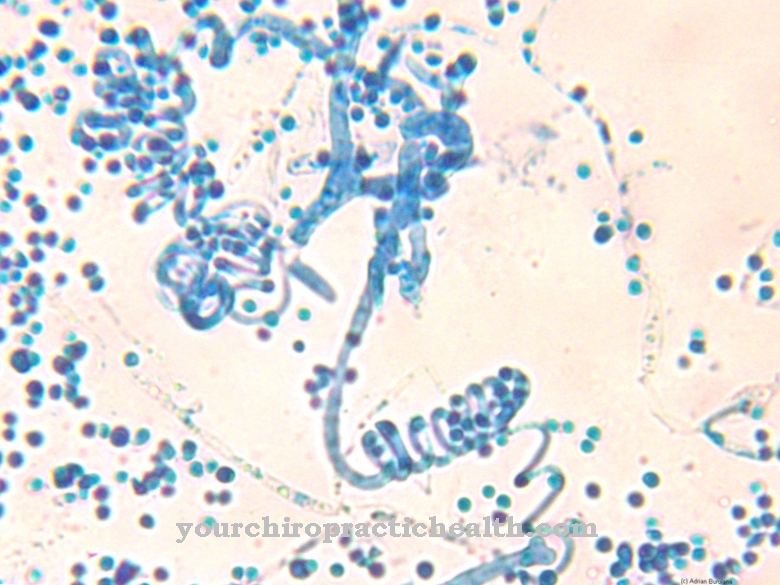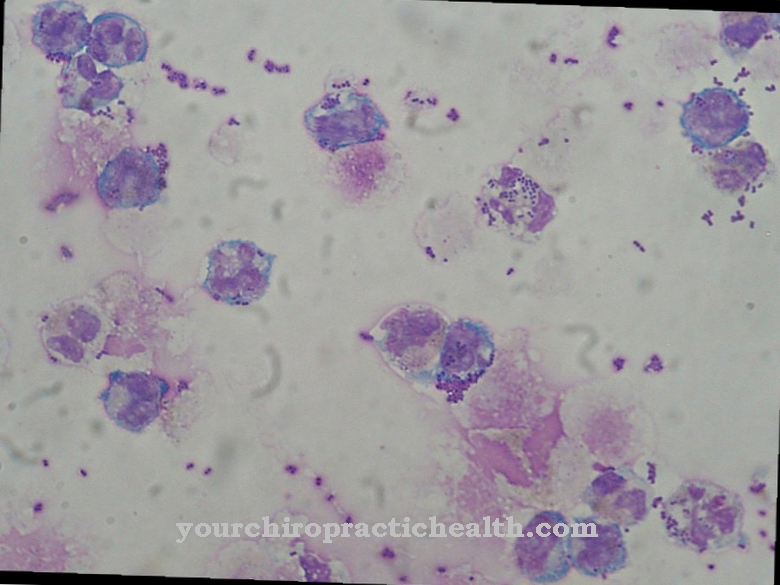Rhizopodsthat belong to the protozoa do not form a uniform type or class of unicellular organisms with a defined cell nucleus (eukaryotes), but they all combine only the ability to develop pseudopodia. Rhizopods embody a variety of protozoa, such as amoebas, radiant animals, sun animals, foraminifera and others. For humans, only a few types of amoeba are important as a harmless component of the intestinal flora and also as pathogens.
What are rhizopods?
Rhizopods, too Root pods called, are assigned to the protozoa, i.e. the unicellular organisms with a cell nucleus. It is not a single species, family or class of unicellular organisms, but eukaryotic unicellular organisms from completely different and independent evolutionary lines. The only common feature that connects them is their ability to develop rapidly changing pseudopodia (pseudopodia). These are protuberances of the cytoplasm, which among other things enable them to actively move about, to eat and to “hold onto” a substrate.
In terms of evolutionary biology, they are very early living beings that have existed for more than a billion years. Most rhizopod species colonize the world's oceans, but a few species also prefer the fresh water of local lakes and rivers or live in the ground.
Almost all rhizopods feed heterotrophically, that is, on organic degradation and waste products. Apart from a few types of amoeba, which are part of the healthy intestinal flora, and a few pathogens that can cause amoebic dysentery, primary amoebic meningoencephalitis or amoebic creatitis, rhizopods have no direct health significance for humans.
Occurrence, Distribution & Properties
Rhizopods, to which orders as diverse as amoebas, foraminifera, sun animals and radiant animals belong with thousands of species and subspecies, are native to all of the world's oceans. Some species are also known as freshwater inhabitants. As mostly free-living primitive animals, they play no role in human health, with the exception of a few species of amoeba.
Most amoeba species with health relevance live as commensals in the large intestine and feed heterotrophically on degradation products that the body's metabolism can no longer utilize. They are part of the healthy intestinal flora and occur worldwide. Amoebas multiply asexually by dividing. First, the cell nucleus divides, so that two cell nuclei are temporarily present in the amoeba before the subsequent division of the cytoplasm completes the division process and one amoeba has created two equal new amoeba, which in turn can divide under favorable growth conditions.
If amoeba living in the intestine are excreted with the stool and find very unfavorable living conditions, they form permanent forms (cysts). By excreting excess water, they shrink into a small ball and surround themselves with a thick capsule. The cysts are very resilient and withstand adverse conditions such as cold, heat and dryness for a long time. Amoebic cysts are almost ubiquitous and after oral ingestion survive the gastrointestinal passage before they leave the cyst stage in the large intestine. This is problematic if the ingested cysts originate from one of the few pathogenic amoeba species.
Meaning & function
The health significance of the amoeba strains that live as commensals in the human large intestine has not (yet) been adequately researched. It seems certain that they do not parasitize and cause no recognizable damage if the immune system is intact. One positive effect is that they utilize degradation products, which the body metabolism can no longer catabolize further, through phagocytosis and thus make a contribution to “keeping the colon clean”. It is not known whether the amoebas supply the body with useful substances.
Known non-pathogenic strains of the amoeba are Entamoeba hartmanni, Entamoeba coli and three other species, of which Dientamoeba fragilis also occurs as a pathogen, especially when the amoeba encounters a weakened immune system. Dientamoeba fragilis is morphologically very similar to the species Entamoeba histolytica, which is known to cause amoebic dysentery.
Illnesses & ailments
The dangers and risks that exist for humans in connection with rhizopods are largely limited to a few pathogenic amoeba strains and to those that are described as facultatively pathogenic if the appropriate conditions, such as an immune system weakened by disease or artificial immunosuppression, are given.
The most important and most common pathogenic amoeba is Entamoeba histolytica. It is the causative agent of amoebic dysentery, also known as amoebiasis. Amoebic dysentery occurs mainly in the tropics. An infection usually occurs through oral ingestion of the cysts, the resistant permanent form of the Entamoeba histolytica. Strictly speaking, Entamoeba histolytica is also a facultative pathogen, since only about 10 percent of infected people develop symptoms, which, however, can take a serious course if left untreated.
If the symptoms are limited to the gastrointestinal tract, it is an intestinal amebiasis. In rare cases, the amoeba get into the bloodstream and can affect other organs. It is then an extraintestinal amebiasis.
A very rare infectious disease is primary amoebic meningoencephalitis (PAM).It is caused by the amoeba Naegleria fowleri, an amoeba that occurs worldwide in fresh water, mainly in the tropics and subtropics and in warm springs. In very rare cases, after entering the nose, Naegleria fowleri can penetrate the olfactory epithelium and nerve tracts into the brain and trigger PAM, which can be fatal in a very short time.
Acanthamoeba is also a free-living amoeba with worldwide distribution that lives in freshwater lakes and rivers as well as in the ground. However, it is also often found in drinking water and swimming pools. In very rare cases, the amoeba causes acanthamoeba keratitis, an inflammation of the cornea of the eye. It mostly affects contact lens wearers whose contact lenses absorb the amoeba in the infected cleaning fluid and infect the cornea of the eye when they are inserted. In extremely rare cases, it can lead to meningitis, granulomatous amoebic encephalitis.




























